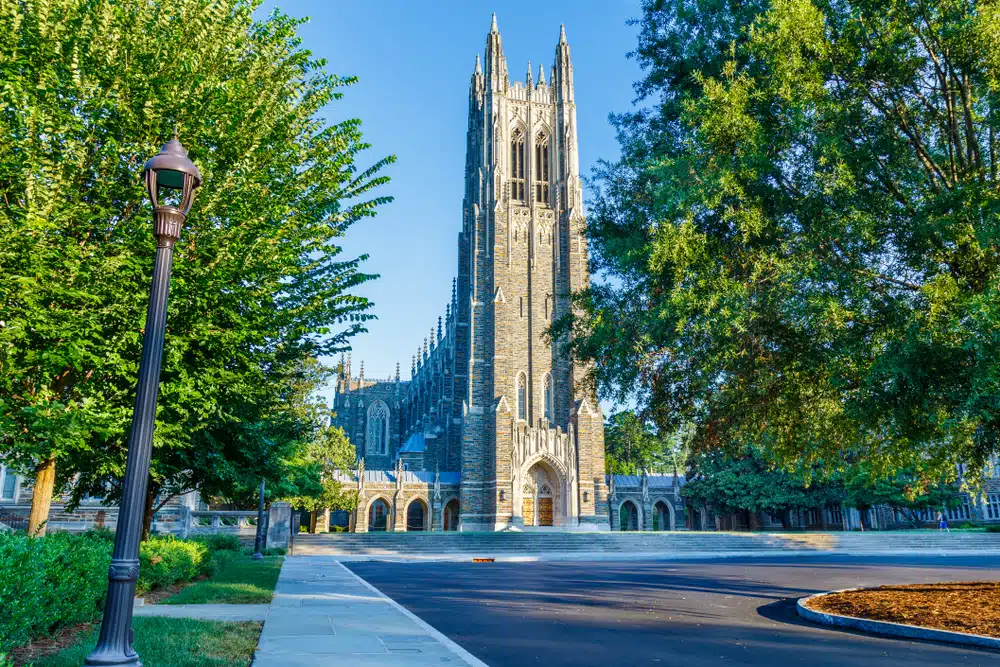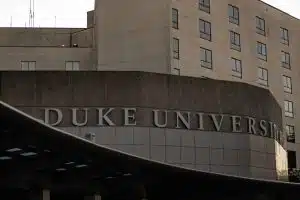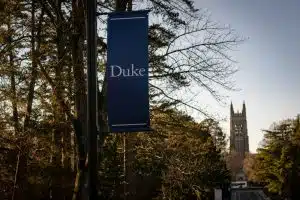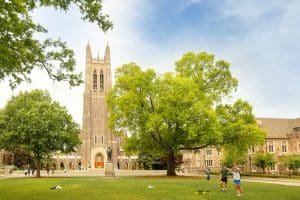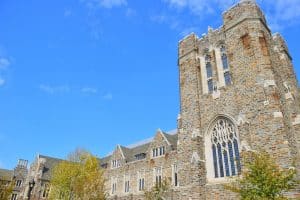Duke Campus Tour: Into the Blue Devil’s World
Welcome, prospective Blue Devils! Whether you’re considering becoming a part of the Duke University community or just want to explore the wonders of this prestigious institution, you’re in for an exhilarating journey. We’re here to take you on an extensive tour through the captivating Duke University campus, where every corner is steeped in history, charm, and academic excellence. So, tighten your seatbelts and get ready to delve deep into this amazing experience.
The Power of First Impressions
You’ve heard the age-old saying that the first impression is the last impression, and Duke University takes this to heart. As you set foot on this awe-inspiring campus, you’ll quickly understand why.
The Gothic architecture, meticulously maintained lawns, and an air of academic sophistication all combine to make your jaw drop. It’s not just a campus; it’s a testament to the university’s commitment to grandeur and education.
Duke Chapel
Our first stop on this journey is the magnificent Duke Chapel, a place that transcends mere worship. It stands as a symbol of Duke University’s unwavering dedication to both faith and diversity. The architecture of this spiritual haven is nothing short of awe-inspiring, almost like a scene straight out of Hogwarts, but with a Southern twist.
Duke Chapel isn’t just a religious site; it’s a center for contemplation, a testament to the university’s commitment to inclusivity. Regardless of your beliefs or background, a visit to this sacred place is an experience that will leave an indelible mark on your memory.
Cameron Indoor Stadium
For all the sports enthusiasts out there, Cameron Indoor Stadium is a hallowed ground, and it’s not just about basketball. This is the place where legends are born, and dreams take flight. As you step inside, you can almost taste the electric atmosphere that’s steeped in the history of the Duke Blue Devils.
Whether you’re a fan of basketball or not, you can’t help but be drawn into the magic of the game. The roaring crowds, the intense rivalries, and the euphoria of victory—all these emotions collide in this iconic arena. It’s a place where even non-sports enthusiasts find themselves cheering for the home team, caught in the infectious spirit of camaraderie.
West Campus vs. East Campus
Duke’s campus is a unique blend of tradition and modernity, and it’s divided into two distinct worlds: West Campus and East Campus. Each campus has its unique charm and character that collectively shape the full Duke experience.
West Campus is a journey through history and tradition. It’s where the university’s roots are deeply entrenched. The gothic architecture of West Campus, including the iconic Duke Chapel, oozes an aura of timelessness. As you wander through these historic halls, you’ll feel as if you’ve stepped back in time while still enjoying the conveniences of modern life.
On the other hand, East Campus offers a more contemporary atmosphere. It’s where you’ll find state-of-the-art facilities, vibrant student life, and a dash of modernity. Here, the focus is on innovation, and it’s the hub of many academic activities, research, and vibrant campus life.
Exploring both campuses is like experiencing two different worlds within the same universe. It’s the yin and yang of Duke University, each complementing the other to provide a holistic college experience.
Dining with the Blue Devils
All that touring can work up an appetite, and Duke’s dining options are a delightful surprise. It’s not your typical cafeteria fare; it’s a gastronomic journey that caters to all palates. You’ll find everything from gourmet food trucks to elegant dining halls serving up a cornucopia of culinary delights.
Dining at Duke is more than just sustenance; it’s a communal experience. It’s where you bond with fellow students over sumptuous meals, exchange ideas, and create lifelong memories. Food is a language that transcends cultures, and Duke’s dining options speak this language fluently.
Art and Culture – Nasher Museum
Duke University is not just about academics and sports; it’s a hub of art and culture. The Nasher Museum stands as a testament to this commitment to the arts. It’s a hidden gem that awaits your exploration.
As you step into the Nasher Museum, you’ll be greeted by a world of artistic wonders. The galleries here house an impressive collection of contemporary art, classical masterpieces, and thought-provoking exhibitions. It’s a place that stimulates your imagination, sparks creativity, and opens your eyes to the diverse world of art.
The Nasher Museum is not just for art connoisseurs; it’s a place for everyone to embrace culture, appreciate different forms of expression, and experience the boundless creativity of the human mind.
The Gardens
Amidst the hustle and bustle of campus life, there’s a serene oasis waiting to be discovered – the Sarah P. Duke Gardens. Stepping into these gardens is like entering a fairy tale. Vibrant flowers, tranquil ponds, and winding pathways create an atmosphere of serenity and peace.
It’s not just a place for nature enthusiasts; it’s a sanctuary for anyone seeking a moment of respite from their busy lives. A leisurely stroll through these gardens can do wonders for your mental and emotional well-being. It’s where you can escape the chaos of exams and assignments, find solace in the beauty of nature, and rejuvenate your spirit.
Living Like a Blue Devil – Residence Halls
Curious about the on-campus living experience? Duke’s residence halls offer more than just a roof over your head. They’re designed to be your home away from home, ensuring that you feel comfortable, secure, and part of a close-knit community.
When you step into your residence hall, you’re not just entering a room; you’re joining a community. It’s a place where friendships are forged, late-night study sessions turn into memorable conversations, and shared experiences create bonds that last a lifetime.
Duke’s commitment to providing an exceptional on-campus experience is evident in its well-maintained residence halls, where you’ll find a balance of privacy and community. Living here is more than just an accommodation; it’s an integral part of your Duke journey.
Research Opportunities
For the academically inclined, Duke University is a playground of research opportunities. Whether you’re interested in the medical field, technology, humanities, or any other area, you’ll find avenues to pursue your passion.
Engaging in research at Duke isn’t just about acquiring knowledge; it’s about creating knowledge. The university fosters an environment where students actively participate in groundbreaking research, contributing to the body of knowledge in their chosen fields. It’s a hands-on, immersive experience that prepares you for the challenges of the real world and opens doors to limitless possibilities.
Blue Devil Traditions – Unleash the Fun!
Duke is not all work and no play. The campus is teeming with traditions and quirky rituals that make being a Blue Devil an unforgettable experience. These traditions unite students, alumni, and the entire Duke community in a web of camaraderie and fun.
From the infamous Krzyzewskiville, where students camp out in tents for coveted basketball game tickets, to the raucous cheers at Cameron Indoor Stadium, Duke’s traditions infuse energy and a sense of belonging. The “Crazies” – the dedicated student section at basketball games – will welcome you with open arms, ready to initiate you into the spirited Duke tradition.
These traditions aren’t just about having fun; they’re about creating lifelong memories and fostering a sense of pride and unity within the Blue Devil family.
The Friendly Neighborhood – Durham
Duke University isn’t an isolated island; it’s nestled in the heart of Durham, North Carolina. This vibrant city is an extension of the Duke experience, offering a rich tapestry of culture, history, and warmth.
Durham is more than just a backdrop; it’s an active participant in your Duke journey. From lively music scenes to diverse local food options, the city complements your academic life with a vibrant cultural life. It’s a place where you can unwind, explore, and immerse yourself in the welcoming community that surrounds the university.
Embracing Diversity
Duke University takes great pride in its diverse student body. The campus is a melting pot of cultures, backgrounds, and perspectives, and it’s this diversity that enriches the Duke experience.
Here, you won’t just meet people from different walks of life; you’ll learn from them, grow with them, and forge friendships that transcend borders. The diverse community at Duke challenges your preconceptions, broadens your horizons, and prepares you for a globalized world.
Embracing diversity isn’t just a slogan here; it’s a way of life. It’s about learning, understanding, and celebrating the richness of human experience.
The Blue Devils – Sports Glory
Duke University isn’t just famous for its basketball team; it excels in a wide range of sports. The spirit of sports culture here is electric and contagious. Whether you’re a seasoned athlete or a casual sports enthusiast, you’ll find a home in the Blue Devils’ sports world.
From soccer to lacrosse and even rowing, Duke’s sports programs offer an opportunity to compete at the highest level. The sports facilities are top-notch, and the support from fellow students and alumni is unwavering. You don’t just cheer for the Blue Devils; you become part of the team, feeling every triumph and heartbreak on the field.
So, if you have a passion for sports, you’ll find a welcoming community here. It’s not just about victory; it’s about the dedication, teamwork, and sportsmanship that make Duke athletes true champions.
Future-Ready Academics
Duke’s academics are more than just a collection of courses and credits; they are a gateway to a future filled with opportunities. The university is committed to preparing you for the ever-evolving world by offering cutting-edge programs and courses that equip you with the skills and knowledge needed to thrive.
As you delve deeper into your chosen field of study, you’ll be guided by renowned professors and mentors who are experts in their respective fields. The academic environment at Duke is not just about theoretical learning; it’s about practical application and critical thinking.
Here, you’re not just learning from textbooks; you’re shaping your future, gaining hands-on experience, and preparing yourself to make a meaningful impact in the world.
Fun Facts and Anecdotes
Duke University is a treasure trove of intriguing tidbits and stories that add charm to the campus experience. From the mysterious origins of the Blue Devil mascot to the unusual traditions that have been passed down through generations, you’ll be captivated by the quirks and legends that surround the university.
One of the most famous anecdotes is the origin of the Blue Devil mascot. It’s said that the name was inspired by a French fighting unit in World War I, and the mascot was adopted to instill a sense of tenacity and bravery in the sports teams. Today, the Blue Devil mascot represents the spirit of Duke, both on and off the field.
Alumni Success Stories
Duke’s legacy of excellence extends beyond graduation. The university’s alumni have achieved remarkable success in various fields, from politics to entertainment, science to business. Duke’s commitment to fostering future leaders is evident in the accomplishments of its alumni.
Take, for instance, former U.S. President Richard Nixon, who graduated from Duke Law School. Or Tim Cook, the CEO of Apple Inc., who earned his MBA from Duke’s Fuqua School of Business. These are just a few examples of the many accomplished individuals who have walked the hallowed halls of Duke.
Duke’s influence on its alumni goes beyond professional success; it instills a sense of responsibility and leadership that extends to making the world a better place.
Frequently Asked Questions (FAQs)
Q1: How can I schedule a campus tour at Duke University?
Scheduling a campus tour at Duke University is simple. You can visit the official Duke University website and look for the “Visit” or “Campus Tours” section. There, you’ll find all the information you need to book a tour that fits your schedule.
Q2: Is there an option for a virtual tour of Duke University if I can’t visit in person?
Absolutely! Duke offers virtual tours for those who can’t make it to campus in person. These virtual tours provide an immersive online experience, complete with 360-degree views and informative guides. You can explore the campus from the comfort of your home.
Q3: When is the best time to visit Duke University for a tour?
The ideal time to visit Duke depends on your preferences. Spring and fall offer pleasant weather and a vibrant campus atmosphere. If you want to experience Duke in full swing, consider visiting during the academic year when the campus is buzzing with activity.
Q4: Are there specific tours for prospective students and their families?
Yes, Duke University offers specialized tours for prospective students and their families. These tours provide a more in-depth look at academics, student life, and the admissions process. It’s a great opportunity to get personalized insights into the Duke experience.
Q5: Can I visit the Duke Chapel without taking a full campus tour?
Certainly! The Duke Chapel is open to the public, and you can visit it independently without a guided tour. It’s a must-see attraction on campus, and you can explore its architectural beauty and historical significance at your own pace.
Final Thoughts
Phew! That’s quite a campus tour, but Duke University is far from ordinary. It’s a realm where history, culture, and academic excellence blend seamlessly, creating a world waiting for you to explore. So, why not plan a visit and experience it all for yourself? You’ll be in for an adventure that will shape your future and stay with you for a lifetime.
It is important to have all the necessary information before making any decision. AdmissionSight is always here to help you with any questions or concerns. We have over ten years of experience helping students successfully navigate the challenging admissions process.
Consult with AdmissionSight and find out how we can help you get into the school of your choice by ensuring that you are fully informed and prepared for the application process. We will work with you to develop a personalized plan that meets your specific needs and goals. We will also provide you with access to our team of experts who can help you with everything from choosing the right schools to writing your essays.
Don’t let the admissions process overwhelm you. Contact AdmissionSight today and let us help you achieve your dreams.



